PRINCETON, NJ -- Hillary Clinton leads Barack Obama by 21 points among non-Hispanic white Democratic voters who don't have a college degree, while Obama leads Clinton by a 19-point margin among white Democratic voters who do have a college degree.
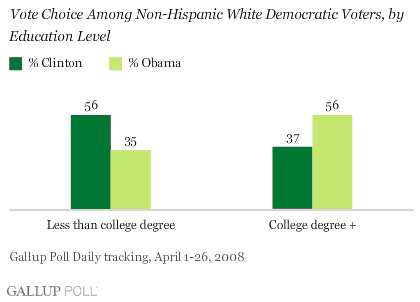
This difference in support by education is evident across all age groups, although it is somewhat stronger among middle-aged white Democrats.
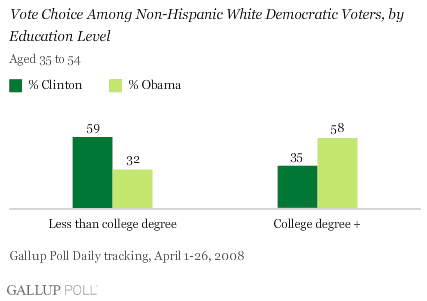
Here we find that Clinton's lead among those without a college degree swells to 27 points, while Obama leads among those with a college degree by an almost-as-large 23 points. In short, the vote pattern of these 35- to 54-year-old white Democratic voters essentially flips, based on the single variable of education.
Much has been made in recent weeks about Obama's failure to connect with blue-collar or working-class white Democrats, in part because of his much-publicized comments about the bitterness of small-town Democrats in Pennsylvania and Ohio.
But an analysis of the pattern of support for the two candidates among the 35- to 54-year-old age group by employment status shows that the strong impact of education persists regardless of whether the individual is employed.
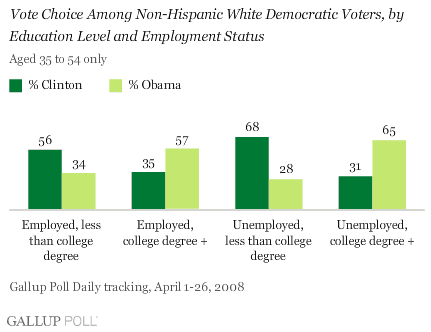
Thus, it may be somewhat of a misnomer to assume that being a worker per se is involved in the equation when Obama's appeal is dissected. Education is a predictor of candidate support -- among these middle-aged white voters -- regardless of working status.
The strength of support for Clinton is not as dramatic among whites under age 35 without a degree as it is among whites 35 to 54. Obama's youth appeal is evident regardless of education in this younger voter category. Still, slight differences remain between these younger voters with no college degree and those who do have a college degree.
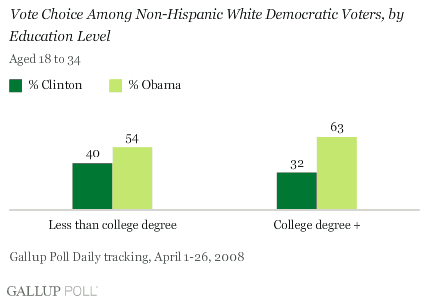
(Among younger white voters who are employed, the impact of education is even less.)
Among white voters 55 and older (the majority of whom are not employed), Clinton wins by an overwhelming 31-point margin among those with less than a college degree, while Obama holds a seven-point margin among those with a college degree.
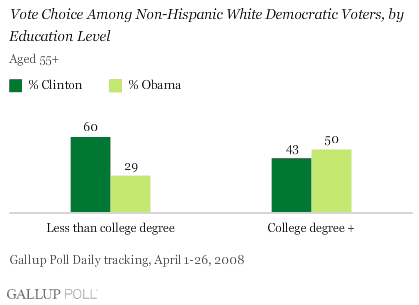
Implications
In the overall sample of 7,999 non-Hispanic white Democratic voters Gallup interviewed between April 1 and April 26, Clinton beats Obama by a 49% to 42% margin. As seen above, Clinton gains this winning margin in part because of her very high percentage of support among those with lower education levels. Obama's support among the well-educated is not strong enough to counteract Clinton's strength among the less well-educated.
These relationships are particularly strong among white middle-aged Democrats between 35 and 54.
Although there has been a lot of discussion about Clinton's and Obama's differential appeal to blue-collar workers, or to members of the "working class," this analysis suggests that for those in the middle-aged years, education is a powerful predictor of differences regardless of one's working status. The relationship persists among those 55 and older, the majority of whom do not work.
Whether Obama is able to change this pattern by convincing working-class white voters that he deserves their support remains to be seen. And of course, the current analysis is based on national Democratic voters, while patterns of support can vary on a state-by-state basis.
Survey Methods
Results are based on telephone interviews with 7,999 non-Hispanic, white Democratic voters, aged 18 and older, conducted April 1-26, 2008. For results based on this total sample, one can say with 95% confidence that the maximum margin of sampling error is ±1 percentage points. The margin of sampling error is larger among subgroups.
Interviews are conducted with respondents on land-line telephones (for respondents with a land-line telephone) and cellular phones (for respondents who are cell-phone only).
In addition to sampling error, question wording and practical difficulties in conducting surveys can introduce error or bias into the findings of public opinion polls.
To provide feedback or suggestions about how to improve Gallup.com, please e-mail feedback@gallup.com.
